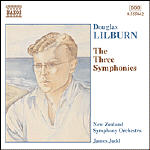Lilburnís three symphonies represent the heart of his creativity. The first and second are the composerís response to the elevating power of landscape whilst the third is an admission that the natural world is beautiful, restorative and necessary, yet also vulnerable and transient.
Douglas Lilburn grew up on "Drysdale", an isolated hill country farm leading to the high mountain plateau at the centre of New Zealandís North Island. He often described his boyhood home as "paradise" and his first major orchestral work, the Drysdale Overture (1937), written whilst a student under the aegis of Ralph Vaughan Williams at the Royal College of Music in London, explores the home hills, bush and stream as primal sites of imaginative wonder. "Iím left," said Lilburn, recalling the impression of Drysdale, "with that lovely Mark Twain image of Jim and Huckleberry drifting their barge down that great river, looking up at the stars and wondering Ďwhether they was made, or only just happened.í"
Symphonies Nos.1 - 3
